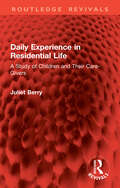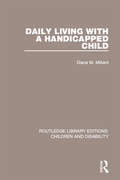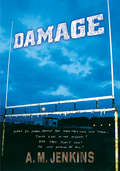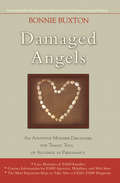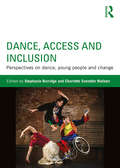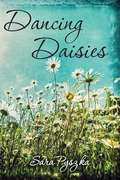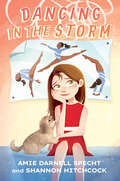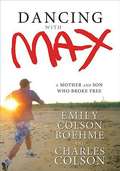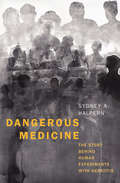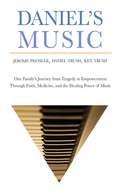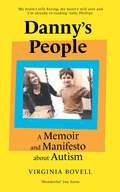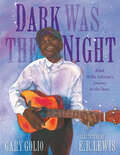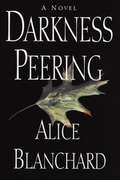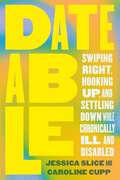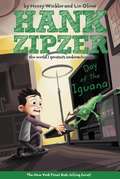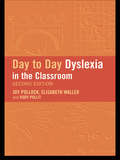- Table View
- List View
Daily Experience in Residential Life: A Study of Children and Their Care-Givers (Routledge Revivals)
by Juliet BerryFirst published in 1975, Daily Experience in Residential Life, based on questionnaires completed by students during their residential placements, breaks new ground with fresh implications for social work training and practice.The author first examines daily life experiences of children in a wide range of residential provision, with particular reference to methods of handling uncooperative children; second, to consider effective ways of enabling caregivers to provide helpful, rather than neutral or even punitive, daily treatment. Her findings suggest that children with similar needs differ greatly in the quality of care they receive and that variations, particularly in methods of discipline and control, depend less upon theoretical principles than upon their caregivers’ immediate pressures in practice. Therefore, her major recommendation (also applicable to children in foster-care, day school or at risk in their own homes, and to dependent adults either at home or in institutional care) is that the caregivers themselves require appropriate ongoing experience of professional support in their very difficult task.
Daily Living with a Handicapped Child (Routledge Library Editions: Children and Disability #11)
by Diana M. MillardFirst published in 1984, this book focuses on the support and reassurance needed by parents of children with handicaps. It provides a practical guide in relation to daily care and is equally as relevant to professionals, therapists, teachers, doctors and psychologists who must advise parents. Written by an Occupational Therapist, the book highlights the need to make such children as independent as possible and gives advice on care of a special baby, modifications to the home environment, the needs of a child with a physical handicap, problems of educational handicap, and the place of a child in the family and community.
Damage (Series In Microscopy In Materials Science Ser.)
by A. M. JenkinsAs the Pride of the Panthers, football star Austin Reid is a likable guy, good with the ladies. Lately though, he doesn't like his life -- or anything else -- so much. And the worst part is that he can't seem to figure out why.
Damaged Angels: An Adoptive Mother Discovers the Tragic Toll of Alcohol in Pregnancy
by Bonnie BuxtonPart heartfelt memoir, part practical guide, "Damaged Angels" recounts Bonnie Buxton's struggles to raise an adopted daughter whom she didn't realize was afflicted with fetal alcohol disorder. Her book also offers guidance to parents who have children with FASD. By the time BonnieOCOs daughter Colette hit first grade, her parents were coping with her frequent stealing and lying, and the necessity of special education. At fourteen, she discovered drugs and sex; by eighteen, she was a crack addict living on the streets. After many frustrating years consulting numerous therapists, a TV news story gave Bonnie the answer she was looking for ? and sent her on a quest for a diagnosis and help for Colette. "Damaged Angels" can aid and comfort all those affected by FASD ? the most common cause of intellectual impairments in most industrialized nations ? and reduce the number of babies born with this disorder in the future. The most important book on fetal alcohol disorder since Michael DorrisOCOs "The Broken Cord, Damaged Angels" is a book for every parent, practitioner, and teacher working with a child with FASD. "
Damn Bunch of Cripples: My Politically Incorrect Education in Disability Awareness
by Lew ShaverI was sitting in a small upstairs room attempting to write this narrative of my education in disability awareness. For over 30 years I have been involved in working with individuals with disabilities as a coach and administrator on the intercollegiate, national and international levels. When I started this journey, at a small, Midwestern University, I had no idea of what I was getting myself into. Now that I have traveled this educational path I have come to realize that it may have been one of the most important learning experiences of my life, an experience I feel needs to be shared. In putting this narrative together, one very real issue I struggled with was how to deal with the present climate of political correctness. My decision was to tell the stories as I remember them, in the language as I remember. To do differently would change and compromise the actual experience. Thus, this is a sharing of feelings and experiences that a coach and his athletes spent in timeless hours in a gym practicing and competing, of thousands of miles traveled throughout the United States and beyond, and days and nights spent together in laughter and frustration.
Dance, Access and Inclusion: Perspectives on Dance, Young People and Change
by Charlotte Svendler Nielsen Stephanie BurridgeThe arts have a crucial role in empowering young people with special needs through diverse dance initiatives. Inclusive pedagogy that integrates all students in rich, equitable and just dance programmes within education frameworks is occurring alongside enabling projects by community groups and in the professional dance world where many high-profile choreographers actively seek opportunities to work across diversity to inspire creativity. Access and inclusion is increasingly the essence of projects for disenfranchised and traumatised youth who find creative expression, freedom and hope through dance. This volume foregrounds dance for young people with special needs and presents best practice scenarios in schools, communities and the professional sphere. International perspectives come from Australia, Brazil, Cambodia, Canada, Denmark, Fiji, Finland, India, Indonesia, Jamaica, Japan, Malaysia, New Zealand, Norway, Papua New Guinea, Portugal, Singapore, South Africa, Spain, Taiwan, Timor Leste, the UK and the USA. Sections include: inclusive dance pedagogy equality, advocacy and policy changing practice for dance education community dance initiatives professional integrated collaborations
Dancing Daisies
by Sara PyszkaBrynn has cerebral palsy and her relationship with her two best friends is just shattered. Brynn is looking forward more than ever to her summer at Camp Lakewood.
Dancing in the Storm
by Amie Darnell Specht Shannon HitchcockIn the tradition of Out of My Mind and Rules, and inspired by the co-author&’s own life, this is a heartfelt, candid, and illuminating story of a girl learning to live fully with a rare genetic disorder.Kate&’s life in Baton Rouge, full of friends and family, gymnastics and Girl Scouts, is just plain great. But then, at the age of twelve, she suddenly develops a mysterious shoulder pain that won&’t go away . . . and that will change her life forever. It turns out that Kate has one of the rarest genetic disorders in the world, Fibrodysplasia Ossificans Progressiva. FOP causes bone to form in places in the body where it shouldn&’t, and there&’s no cure yet. Kate will need to learn how to live with this difficult new reality, helped by those close to her and by a new pen pal named Amie, who has been living with FOP for years.Drawing upon much of Amie Specht&’s own experiences with FOP, she and esteemed novelist Shannon Hitchcock have created a poignant, eye-opening, and uplifting story of finding courage and joy in the face of adversity.
Dancing with Max: A Mother and Son Who Broke Free
by Emily Colson Charles W. ColsonMeet a remarkable young man. Max doesn't communicate like we do. But he communicates better than we do about the most important things. Max doesn't think like we do. But his actions reflect deep spiritual truths. With candor and wit, Emily Colson shares about her personal battles and heartbreak when, as a suddenly single mother, she discovers her only child has autism. Emily illuminates the page with imagery making you laugh, making you cry, inspiring you to face your own challenges. Chuck Colson, in his most personal writing since Born Again, speaks as a father and grandfather. It is a tender side Max brings out of his grandfather, a side some haven't seen. As Emily recalls her experiences, we discover that Max's disability does not so much define who he is, but reveals who we are. Dancing with Max is not a fairy tale with a magical ending. It's a real life story of grace and second chances and fresh starts in spite of life's hardest problems. And Max? Max will make you fall in love with life all over again, leaving you dancing with joy.
Dancing with Max: A Mother and Son Who Broke Free
by Emily Colson Charles W. ColsonMeet a remarkable young man. Max doesn’t communicate like we do. But he communicates better than we do about the most important things. Max doesn’t think like we do. But his actions reflect deep spiritual truths. With candor and wit, Emily Colson shares about her personal battles and heartbreak when, as a suddenly single mother, she discovers her only child has autism. Emily illuminates the page with imagery—making you laugh, making you cry, inspiring you to face your own challenges. Chuck Colson, in his most personal writing since Born Again, speaks as a father and grandfather. It is a tender side Max brings out of his grandfather, a side some haven’t seen. As Emily recalls her experiences, we discover that Max’s disability does not so much define who he is, but reveals who we are. Dancing with Max is not a fairy tale with a magical ending. It’s a real life story of grace and second chances and fresh starts in spite of life’s hardest problems. And Max? Max will make you fall in love with life all over again, leaving you dancing with joy.
Dangerous Medicine: The Story behind Human Experiments with Hepatitis
by Sydney A. HalpernThe untold history of America&’s mid-twentieth-century program of hepatitis infection research, its scientists&’ aspirations, and the damage the project caused human subjects &“Sydney Halpern has written a compelling, if unsettling, history of hepatitis research during World War II and the Cold War. It will become a must-read for anyone interested in bioethics and medical history.&”—Susan E. Lederer, author of Subjected to Science and Flesh and Blood From 1942 through 1972, American biomedical researchers deliberately infected people with hepatitis. Government-sponsored researchers were attempting to discover the basic features of the disease and the viruses causing it, and to develop interventions that would quell recurring outbreaks. Drawing from extensive archival research and in-person interviews, Sydney Halpern traces the hepatitis program from its origins in World War II through its expansion during the initial Cold War years, to its demise in the early 1970s amid an outcry over research abuse. The subjects in hepatitis studies were members of stigmatized groups—conscientious objectors, prison inmates, the mentally ill, and developmentally disabled adults and children. The book reveals how researchers invoked military and scientific imperatives and the rhetoric of a common good to win support for the experiments and access to recruits. Halpern examines the participants&’ long-term health consequences and raises troubling questions about hazardous human experiments aimed at controlling today&’s epidemic diseases.
Daniel Isn't Talking
by Marti LeimbachMelanie Marsh is an American living in London with her British husband, Stephen, and their two young children. The Marshes' orderly home life is shattered when their son Daniel is given a devastating diagnosis. Resourceful and determined not to acceptt what others, including her husband, say is inevitable, Melanie finds an ally in the idealistic Andy, whose unorthodox ideas may just prove that Daniel is far more "normal" than anyone imagined. Daniel Isn't Talking is a moving story of a family in crisis, told with warmth, compassion, and humor.From the Trade Paperback edition.tephen's ex-fiancée, a woman apparently intent on restaking her claim on Stephen. Melanie does have one strong ally in Andy, a talented and off-the-wall play therapist who specializes in teaching autistic children. Andy proves that Daniel is far more capable than anyone imagined, and Melanie finds herself drawn to him even as she staggers toward resolving her marriage.Daniel Isn't Talking is a moving, deeply absorbing story of a family in crisis. What sets it apart from most fiction about difficult subjects is the author's ability to write about a sad and frightening situation with a seamless blend of warmth, compassion and humor.
Daniel Kish: A Different Way to See (Fountas & Pinnell Classroom, Guided Reading)
by Julius SmithersonNIMAC-sourced textbook. CHANGING IDEAS ABOUT BLIND PEOPLE. Daniel Kish is blind, but he learned how to see things around him. Now he's teaching blind children how to see too.
Daniel's Music: One Family's Journey from Tragedy to Empowerment Through Faith, Medicine, and the Healing Power of Music
by Jerome Preisler The Trush FamilyIn 1997, Daniel Trush, a bright, active, outgoing twelve-year-old, collapsed on the basketball court and fell into a deep coma. Rushed to the hospital, he was found to have five previously undetected aneurysms in his brain. One had burst, causing a massive cerebral hemorrhage.While Daniel remained comatose, the uncontrolled pressure inside his skull caused him to suffer multiple strokes. Tests showed that his brain functions had flat-lined, and doctors would soon tell his parents his chances of survival were slim to none--or that he'd likely remain in a vegetative state if he awakened.But the doctors were wrong.Daniel's traumatic injury did not bring his life to a premature end. Thirty days after lapsing into a coma, he would return to consciousness, barely able to blink or smile. Two years later, he took his first extraordinary steps out of a wheelchair. A decade after being sped to the emergency room, Daniel Trush completed the New York Marathon.But his incredible journey into the future had just begun. With music having played a crucial role in his recovery, Danny and his family launched Daniel's Music Foundation, a groundbreaking nonprofit organization for people with disabilities. In time DMF would be honored on a Broadway stage by the New York Yankees, gaining notoriety and admiration across America.Daniel's Music is the gripping story of Daniel's recovery against odds experts said were insurmountable; of medical science, faith, and perseverance combining for a miracle; and of an average family turning their personal trials into a force that brings joy, inspiration, and a powerful sense of belonging to all those whose lives they touch.
Danny's People: A Memoir and Manifesto About Autism
by Virginia BovellSociety disables us more than autism ever could &‘My brain&’s still fizzing, my heart&’s still sore and I&’m already re-reading&’ Sally Phillips Virginia&’s son Danny has a way of lighting up a room. He&’s warm, personable and has an infectious laugh. He forms lasting relationships and has known his best friend since they were little. He is also nonverbal and autistic, and requires round-the-clock care and a liquid diet. And for this reason, there are many who would rather not encounter Danny. Challenging the view that autism is something that needs to be &‘cured&’, Virginia Bovell testifies to the extraordinary care Danny has received for over 30 years and the everyday kindness and decency of the people – &‘the band of angels&’ – that surround him. She asks us to consider what makes a thriving individual versus an inadequate one; what it means to be ill versus what it means to not to conform; what roles society values and rewards; and how humans might flourish outside of failing political and economic systems. 'An inspiring testament and a celebration of neurodiversity.' Manni Coe, author of Brother. Do. You. Love. Me
Darcy's Dog Dilemma
by Joni Eareckson Tada Steve JensenDarcy is a teenager who is paralyzed from the waist down. When Darcy sees a guide dog in a shopping mall, she wonders if a service dog is the right choice for her. Prayer and reflection help her make the decision. A Christian-based novel for teens.
Dark Sunshine
by Dorothy LyonsTwo years before, horse-loving Blythe Hyland would have been thrilled with the news that the family was moving back to an Arizona ranch, but now--what difference did it make to her? What could a thin, listless girl, crippled by polio, do on a ranch? Then the haunting vision of Blind Man's Pocket, a deep spring-fed valley tucked away in a range of mountains, tempted her to try riding a horse again. And when she had conquered her initial panic, Blythe felt that it might be hers once more. It was in Blind Man's Pocket Blythe found Dark Sunshine, a magnificent wild mare that had been trapped by a landslide. From the moment she learned it was possible to rescue the buckskin, Blythe determined that, crutches or no, she would train and ride her. It was slow, often painful work for the crippled girl, but when an endurance ride offered Blythe her only chance to win athletic honors toward a scholarship, both horse and rider were ready for the grueling test. Dorothy Lyons' earlier books have established her as a favorite writer of horse stories for older girls. In this moving story of a girl whose courage overcame the handicap of a useless leg, she has created an inspiring book that young readers will remember.
Dark Was the Night: Blind Willie Johnson's Journey to the Stars
by Gary GolioThe poignant story of Blind Willie Johnson--the legendary Texas musician whose song "Dark Was the Night" was included on the Voyager I space probe's Golden RecordWillie Johnson was born in 1897, and from the beginning he loved to sing--and play his cigar box guitar. But his childhood was interrupted when he lost his mother and his sight. How does a blind boy make his way in the world? Fortunately for Willie, the music saved him and brought him back into the light. His powerful voice, combined with the wailing of his slide guitar, moved people. Willie made a name for himself performing on street corners all over Texas. And one day he hit it big when he got a record deal and his songs were played on the radio. Then in 1977, his song--"Dark Was the Night"--was chosen to light up the darkness when it was launched into space on the Voyager I space probe's famous Golden Record. His immortal song was selected for the way it expresses the loneliness humans all feel, while reminding us we're not alone.
Darkness Peering
by Alice BlanchardWinner of the prestigious Katherine Anne Porter Prize for Fiction, Alice Blanchard makes her electrifying debut as a novelist with this gripping tale of suspense that dares to stare unblinkingly into the darkest recesses of the human heart. The dead girl lay faceup on the edge of the pond, a snake coiled in the muddy hollow of one arm. For Police Chief Nalen Storrow, it was a shocking reminder of the violence he thought he'd left behind when he moved his wife and children to Flowering Dogwood, Maine, a town where no one locks their doors. And now Storrow's search for the truth leads to a chilling possibility. . . the murderer might be his own son, Billy. Eighteen years later the murder of the girl in the pond has never been solved. Now a different cop is obsessed with the case--Rachel Storrow, Billy's grown sister. But no sooner does Rachel reopen the investigation than another young woman disappears. Once again Billy is a suspect, though far from the only suspect in town. The harder Rachel peers behind Flowering Dogwood's picture-perfect facade--at the center of which is the respected Winfield School for the Blind and Special Needs--the more the mystery deepens. A cunning psychopath is moving undetected through Rachel's hometown, taking her on a journey of suspicion, doubt, and bone-deep fear. Plunged into a world where darkness follows even the innocent, Rachel must unearth secrets that span decades and face a staggering personal truth. Darkness Peering is more than a harrowing suspense novel of the first rank. It is a powerful portrait of a woman who, like her father, must walk the tightrope between honor and justice, and in doing so tests her own humanity.
Das Sprechen über Studierende mit Behinderung aus europäischer Perspektive: Eine vergleichende Diskursanalyse
by Robert AustDas vorliegende Buch analysiert den Diskurs über Studierende mit Behinderung. Grundlage bilden Interviews mit Hochschulmitarbeitenden aus fünf europäischen Universitäten. Vor dem Hintergrund der Verabschiedung der UN-Behindertenrechtskonvention und ihrer globalen Geltung zeigt sich die Relevanz solcher Analysen. Denn die chancengleiche Teilhabe in Hochschulen verlangt nicht allein rechtliche Anpassungen, sondern ebenso subjektive Verwendungen und Übersetzungen von Mitarbeitenden auf lokaler Ebene. Aus einer poststrukturalistischen Perspektive, die an Michel Foucault und Judith Butler anschließt, untersucht der Autor das Sprechen dieser Mitarbeitenden über Behinderung. Die Ergebnisse verdeutlichen zum einen, dass ein nicht-behinderter Normalitätsbegriff als diskursiver Ankerpunkt für Studierende mit Behinderung fungiert. Zum anderen wird sichtbar, dass Behinderung nicht als ontologisch feste Kategorie betrachtet werden kann, sondern durch machtvolle Wissensformationen, Subjektivationen und Anrufungen immer wieder neu hervorgebracht wird. Die vergleichende Analyse zwischen den europäischen Universitäten offenbart sowohl gemeinsame diskursive Praktiken als auch differente Anerkennungs- und Übersetzungsprozesse.
Data on Blindness and Visual Impairment in the U. S.: A Resource Manual on Social Demographic Characteristics, Education, Employment and Income, and Services Delivery (2nd edition)
by Corinne KirchnerData from a wide variety of sources cover age, gender, race and ethnicity, education, employment and income, service delivery systems, vision services, employment-related services, and income benefits program.
Dateable: Swiping Right, Hooking Up, and Settling Down While Chronically Ill and Disabled
by Jessica Slice Caroline CuppA much-needed guide for disabled and chronically ill people to dating - from apps to hooking up, sex, and more - from disabled essayist and author Jessica Slice and bioethicist Caroline Cupp. Disabled people date, have casual sex, marry, and parent. Yet our romantic lives are conspicuously absent from the media and cultural conversation. Sexual education does not typically address the specific information needed by disabled students. Mainstream dating apps fail to include disability as an aspect of one&’s identity alongside race, ethnicity, gender identity, and sexual orientation. The few underutilized disability-focused apps are paternalistic and unappealing. Bestselling dating books do not address disability, and the few relationship books marketed to disabled people focus on the mechanics of sex rather than the complex interactions that create the conditions for it. In Dateable, disabled authors Jessica Slice Caroline Cupp team up to address the serious gap in the dating space. Dateable is the first book on disabled dating and relationships; it&’s a dating guide made especially for disabled and chronically ill people, that also calls in nondisabled readers. Jessica and Caroline take on everything from rom-com representation and dating apps to sex and breakups with a strong narrative underpinning and down-to-earth advice. The book is as much a practical tool as it is an empowering guide.
David
by William R. ThrushThe outstanding life of David L. Gregal who was blind from birth in 1938 to 2004. The Washington Post cited him as one of the outstanding person's to pass away in 2004. The church where his funeral was held, was overflowing with people who knew him. The author was a life long friend of Dave's from his earliest days.
Day of the Iguana (Hank Zipzer, the World's Greatest Underachiever #3)
by Henry Winkler Lin OliverIt's science project time in Ms. Adolf's class. This is good news and bad news for Hank--he loves science, but he hates the report part. So Hank turns to TV to take his mind off things. But when the program directory scrolls by too quickly for Hank to know what's on, he decides to take apart the cable box to try to slow down the crawl. Great! Now Hank has found the perfect science project! But what he wasn't counting on was his sister's pet iguana laying eighteen eggs in the disassembled cable box. How is Hank going to get out of this one?
Day-to-Day Dyslexia in the Classroom
by Rody Politt Joy Pollock Elisabeth WallerDyslexia cuts across class, age and intelligence. All schools will have pupils with dyslexia and teachers of children of all ages need to be aware of the teaching methods and approaches which are most effective with these children. This fully revised and updated edition of a classic text offers invaluable advice to teachers on how they can recognize specific learning difficulties and give practical help to children in their classes. Written in clear, jargon-free language it provides guidelines on the way children with dyslexia learn language and achieve literacy and numeracy skills. It also includes chapters on handwriting, study skills and classroom management, whilst bearing in mind numerous demands made on classroom teachers. This new edition includes: * the National Literacy Strategy* how to make effective use of Teaching Assistants* an exploration of physical development* commentary on teaching children with diagnosed dyspraxia and Attention Deficit Disorder.
